Similar presentations:
Computation of Large-Scale Genomic Evaluations
1. Computation of Large-Scale Genomic Evaluations
Paul VanRadenAnimal Improvement Programs Laboratory
Agricultural Research Service, USDA
Beltsville, MD
Paul.vanraden@ars.usda.gov
University of Maryland Animal Science seminar (1)
Paul VanRaden
2013
2. Early genomic theory
ll
l
l
Nejati-Javaremi et al (1997) tested use of
genomic relationship matrix in BLUP
Meuwissen et al (2001) tested linear and
nonlinear estimation of haplotype effects
Both studies assumed that few (<1,000)
markers could explain all genetic variance (no
polygenic effects in model)
Polygenic variance was only 5% with 50,000
SNP (VanRaden, 2008), but 50% with 1,000
University of Maryland Animal Science seminar (2)
Paul VanRaden
2013
3. Multi-step genomic evaluations
ll
l
l
l
Traditional evaluations computed first and used as
input data to genomic equations
Allele effects estimated for 45,187 markers by
multiple regression, assuming equal prior variance
Polygenic effect estimated for genetic variation not
captured by markers, assuming pedigree covariance
Selection index step combines genomic info with
traditional info from non-genotyped parents
Applied to 30 yield, fitness, calving and type traits
University of Maryland Animal Science seminar (3)
Paul VanRaden
2013
4. Single-step genomic evaluation
ll
Benefits of 1-step genomic evaluation
w
Account for genomic pre-selection
w
Expected Mendelian Sampling ≠ 0
w
Improve accuracy and reduce bias
w
Include many genotyped animals
Redesign animal model software used since
1989
University of Maryland Animal Science seminar (4)
Paul VanRaden
2013
5. Pedigree: Parents, Grandparents, etc.
ManfredO-Man
Jezebel
O-Style
Teamster
Deva
Dima
University of Maryland Animal Science seminar (5)
Paul VanRaden
2013
6. O-Style Haplotypes chromosome 15
University of Maryland Animal Science seminar (6)Paul VanRaden
2013
7. Expected Relationship Matrix1
1HO9167 O-StylePGS
PGD
MGS
MGD Sire Dam Bull
Manfred
1.0
.0
.0
.0
.5
.0
.25
Jezebel
.0
1.0
.0
.0
.5
.0
.25
Teamster
.0
.0
1.0
.0
.0
.5
.25
Dima
.0
.0
.0
1.0
.0
.5
.25
O-Man
.5
.5
.0
.0
1.0
.0
.5
Deva
.0
.0
.5
.5
.0
1.0
.5
.25
.25
.25
.25
.5
.5
1.0
O-Style
1Calculated
assuming that all grandparents are unrelated
University of Maryland Animal Science seminar (7)
Paul VanRaden
2013
8. Pedigree Relationship Matrix
1HO9167 O-StylePGS
MGS
MGD Sire
Dam
Bull
.090
.090
.105
.571
.098
.334
Jezebel
.090 1.037
.051
.099
.563
.075
.319
Teamster
.090
.051 1.035
.120
.071
.578
.324
Dima
.105
.099
.120 1.042
.102
.581
.342
O-Man
.571
.563
.071
.102 1.045
.086
.566
Deva
.098
.075
.578
.581
.086
1.060
.573
O-Style
.334
.319
.324
.342
.566
Manfred
1.053
PGD
University of Maryland Animal Science seminar (8)
.573 1.043
Paul VanRaden
2013
9. Genomic Relationship Matrix
1HO9167 O-StylePGS
MGS
MGD Sire
Dam
Bull
.058
.050
.093
.609
.054
.344
Jezebel
.058 1.131
.008
.135
.618
.079
.357
Teamster
.050
.008 1.110
.100
.014
.613
.292
Dima
.093
.135
.100 1.139
.131
.610
.401
O-Man
.609
.618
.014
.131
1.166
.080
.626
Deva
.054
.079
.613
.610
.080 1.148
.613
O-Style
.344
.357
.292
.401
.626
Manfred
1.201
PGD
University of Maryland Animal Science seminar (9)
.613 1.157
Paul VanRaden
2013
10. Difference (Genomic – Pedigree)
1HO9167 O-StylePGS
PGD
MGS MGD Sire Dam
Bull
Manfred
.149
-.032
-.040
-.012
.038
-.043
.010
Jezebel
-.032
.095
-.043
.036
.055
.004
.038
Teamster
-.040
-.043
.075
-.021 -.057
.035
-.032
Dima
-.012
.036
-.021
.097
.029
.029
.059
.038
.055
-.057
.029
.121
-.006
.060
-.043
.004
.035
.029 -.006
.087
.040
.010
.038
-.032
.059
.040
.114
O-Man
Deva
O-Style
University of Maryland Animal Science seminar (10)
.060
Paul VanRaden
2013
11. Pseudocolor Plots ― O-Style
University of Maryland Animal Science seminar (11)Paul VanRaden
2013
12. 1 – Step Equations
Aguilar et al., 2010Model: y = X b + W u + e
+ other random effects not shown
X’ R-1 X X’ R-1 W
W’ R-1 X W’ R-1 W + H-1 k
H-1 = A-1 +
-1 y
b
X’
R
=
u
W’ R-1 y
0 0
0 G-1 – A22-1
Size of G and A22 >300,000 and doubling each year
Size of A is 60 million animals
University of Maryland Animal Science seminar (12)
Paul VanRaden
2013
13. Modified 1-Step Equations
Legarra and Ducrocq, 2011To avoid inverses, add equations for γ, φ
Use math opposite of absorbing effects
X’R-1X X’R-1W
0 0
W’R-1X W’R-1W+A-1k Q Q
0
Q’
-G/k 0
0
Q’
0 A22/k
-1 y
b
X’
R
=
u
W’ R-1 y
γ
0
φ
0
Iterate for γ using G = Z Z’ / [ 2 Σp(1-p)]
Iterate for φ using A22 multiply (Colleau)
Q’ = [ 0 I ] (I for genotyped animals)
University of Maryland Animal Science seminar (13)
Paul VanRaden
2013
14. Genomic Algorithms Tested
l1-step genomic model
w
Add extra equations for γ and φ
(Legarra and Ducrocq)
w
Converged ok for JE, bad for HO
w
Extended to MT using block diagonal
w
Invert 3x3 A-1u, Gγ, -A22φ blocks? NO
w
PCG iteration (hard to debug) Maybe
University of Maryland Animal Science seminar (14)
Paul VanRaden
2013
15. Genomic Algorithms (continued)
ll
Multi-step insertion of GEBV
w
[W’R-1W + A-1k] u = W’R-1y (without G)
w
Previous studies added genomic
information to W’R-1W and W’R-1y
w
Instead: insert GEBV into u, iterate
1-step genomic model using DYD
w
Solve SNP equations from DYD & YD
w
May converge faster, but approximate
University of Maryland Animal Science seminar (15)
Paul VanRaden
2013
16. Data for 1-Step Test
ll
National U.S. Jersey data
w
4.4 million lactation phenotypes
w
4.1 million animals in pedigree
w
Multi-trait milk, fat, protein yields
w
5,364 male, 11,488 female genotypes
Deregressed MACE evaluations for 7,072 bulls
with foreign daughters (foreign dams not yet
included)
University of Maryland Animal Science seminar (16)
Paul VanRaden
2013
17. Jersey Results New = 1-step GPTA milk, Old = multi-step GPTA milk
StatisticCorr(New, Old)
Corr(New, Old)
Corr(DYDg, DYD)
Corr(New, Old)
SD old PTA milk
SD new PTA milk
Old milk trend
New milk trend
University of Maryland Animal Science seminar (17)
Animals
All bulls
Genotyped bulls
Genotyped bulls
Young genomic
Young genomic
Young genomic
1995-2005 cows
1995-2005 cows
0.994
0.992
0.999
0.966
540
552
1644
1430
Paul VanRaden
2013
18. 1-Step vs Multi-Step: Results
Data cutoff in August 2008Evaluation
Parent Average
Multi-Step GPTA
1-Step GPTA
Expected
Regression
.73
.75
.85
.93
Squared
Correlation
.436
.520
.520
Multi-step regressions also improved by
modified selection index weights
University of Maryland Animal Science seminar (18)
Paul VanRaden
2013
19. Computation Required
ll
CPU time for 3 trait ST model
w
JE took 11 sec / round including G
w
HO took 1.6 min / round including G
w
JE needed ~1000 rounds (3 hours)
w
HO needed >5000 rounds (>5 days)
Memory required for HO
w
30 Gigabytes (256 available)
University of Maryland Animal Science seminar (19)
Paul VanRaden
2013
20. Remaining Issues
ll
l
l
Difficult to match G and A across breeds
Nonlinear model (Bayes A) possible with SNP
effect algorithm
Interbull validation not designed for genomic
models
MACE results may become biased
University of Maryland Animal Science seminar (20)
Paul VanRaden
2013
21. Steps to prepare genotypes
ll
Nominate animal for genotyping
Collect blood, hair, semen, nasal swab, or ear
punch
w
Blood may not be suitable for twins
l
Extract DNA at laboratory
l
Prepare DNA and apply to BeadChip
l
Do amplification and hybridization, 3-day process
l
Read red/green intensities from chip and call
genotypes from clusters
University of Maryland Animal Science seminar (21)
Paul VanRaden
2013
22. Ancestor Validation and Discovery
lAncestor discovery can accurately confirm,
correct, or discover parents and more distant
ancestors for most dairy animals because
most sires are genotyped.
l
Animal checked against all candidates
l
SNP test and haplotype test both used
l
Parents and MGS are suggested to breed
associations and breeders since December
2011 to improve pedigrees.
University of Maryland Animal Science seminar (22)
Paul VanRaden
2013
23. Ancestor Discovery Results by Breed
SNP TestMGS
Breed
Haplotype Test
MGS
MGGS
% Confirmed* % Confirmed % Confirmed
Holstein
95 (98)†
97
92
Jersey
91 (92)
95
95
Brown Swiss
94 (95)
97
85
*Confirmation = top MGS candidate matched
true pedigree MGS.
†50K genotyped animals only.
University of Maryland Animal Science seminar (23)
Paul VanRaden
2013
24. Data (Yield and Health)
lOne step model includes:
72 million lactation phenotypes
w 50 million animals in pedigree
w 29 million permanent environment
w 7 million herd mgmt groups
w 11 million herd by sire interactions
w 7 traits: Milk, Fat, Protein, SCS, longevity,
fertility
w Genotypes not yet included
w
University of Maryland Animal Science seminar (24)
Paul VanRaden
2013
25. New Features Added
lModel options now include:
Multi-trait models
w Multiple class and regress variables
w Suppress some factors / each trait
w Random regressions
w Foreign data
w Parallel processing
w Genomic information
w
l
Renumber factors in same program
University of Maryland Animal Science seminar (25)
Paul VanRaden
2013
26. Computation Required: Evaluation
lCPU for all-breed model (7 traits)
ST: 4 min / round with 7 processors and
~1000 rounds (2.8 days)
w MT: 15 min / round and ~1000 rounds
w ~200 rounds for updates using priors
w Little extra cost to include foreign
w
l
Memory required
w
ST or MT: 32 Gbytes (256 available)
University of Maryland Animal Science seminar (26)
Paul VanRaden
2013
27. Computation Required: Imputation
ll
Impute 636,967 markers for 103,070 animals
w
Required 10 hours with 6 processors (findhap)
w
Required 50 Gbytes memory
w
Program FImpute from U. Guelph slightly better
Impute 1 million markers on 1 chromosome (sequences)
for 1,000 animals
w
Required 15 minutes with 6 processors
w
Required 4 Gbytes memory
University of Maryland Animal Science seminar (27)
Paul VanRaden
2013
28. Methods to Trace Inheritance
ll
Few markers
w
Pedigree needed
w
Prob (paternal or maternal alleles inherited)
computed within families
Many markers
w
Can find matching DNA segments without pedigree
w
Prob (haplotypes are identical) mostly near 0 or 1 if
segments contain many markers
University of Maryland Animal Science seminar (28)
Paul VanRaden
2013
29. Haplotype Probabilities
with Few Markers (12 SNP / chromosome)Paternal Probability
1
Dense SNPs
0.5
0
1
129
257
385
513
641
769
897
1025
SNP Number
University of Maryland Animal Science seminar (29)
Paul VanRaden
2013
30. Haplotype Probabilities
with More Markers (50 SNP / chromosome)Paternal Probability
1
Dense SNPs
0.5
0
1
129
257
385
513
641
769
897
1025
SNP Number
University of Maryland Animal Science seminar (30)
Paul VanRaden
2013
31. Haplotyping Program: findhap.f90
lPopulation haplotyping
w
w
w
l
Divide chromosomes into segments
List haplotypes by genotype match
Similar to FastPhase, IMPUTE, or long range phasing
Pedigree haplotyping
w
w
w
Look up parent or grandparent haplotypes
Detect crossovers, fix noninheritance
Impute nongenotyped ancestors
University of Maryland Animal Science seminar (31)
Paul VanRaden
2013
32. Coding of Alleles and Segments
lGenotypes
w
w
l
Haplotypes
w
l
0 = BB, 1 = AB or BA, 2 = AA, 5 = __ (missing)
Allele frequency used for missing
0 = B, 1 = not known, 2 = A
Segment inheritance (example)
Son has haplotype numbers 5 and 8
w Sire has haplotype numbers 8 and 21
w Son got haplotype number 5 from dam
w
University of Maryland Animal Science seminar (32)
Paul VanRaden
2013
33. Population Haplotyping Steps
lPut first genotype into haplotype list
l
Check next genotype against list
w
Do any homozygous loci conflict?
−
−
−
−
w
l
If haplotype conflicts, continue search
If match, fill any unknown SNP with homozygote
2nd haplotype = genotype minus 1st haplotype
Search for 2nd haplotype in rest of list
If no match in list, add to end of list
Sort list to put frequent haplotypes 1st
University of Maryland Animal Science seminar (33)
Paul VanRaden
2013
34. Check New Genotype Against List 1st segment of chromosome 15
Search for 1st haplotype that matches genotype:022112222011221022021110220010110212202000102020120002021
5.16%
4.37%
4.36%
3.67%
3.66%
022222222020020022002020200020000200202000022022222202220
022020220202200020022022200002200200200000200222200002202
022020022202200200022020220000220202200002200222200202220
022020222020222002022022202020000202220000200002020002002
022222222020222022020200220000020222202000002020220002022
Get 2nd haplotype by removing 1st from genotype:
022002222002220022022020220020200202202000202020020002020
3.65%
3.51%
3.42%
3.24%
3.22%
022020022202200200022020220000220202200002200222200202222
022002222020222022022020220200222002200000002022220002220
022002222002220022022020220020200202202000202020020002020
022222222020200000022020220020200202202000202020020002020
022002222002220022002020002220000202200000202022020202220
University of Maryland Animal Science seminar (34)
Paul VanRaden
2013
35. Net Merit by Chromosome Freddie - highest Net Merit bull
100NM$
80
NM$
60
40
20
0
-20 X
2
4
6
8 10 12 14 16 18 20 22 24 26 28 30
-40
University of Maryland Animal Science seminar (35)
Chromosome
Paul VanRaden
2013
36. Net Merit by Chromosome O Man – Sire of Freddie
100NM$
80
NM$
60
40
20
0
-20 X
2
4
6
8 10 12 14 16 18 20 22 24 26 28 30
-40
University of Maryland Animal Science seminar (36)
Chromosome
Paul VanRaden
2013
37. Net Merit by Chromosome Die-Hard - maternal grandsire
100NM$
80
NM$
60
40
20
0
-20 X
2
4
6
8 10 12 14 16 18 20 22 24 26 28 30
-40
University of Maryland Animal Science seminar (37)
Chromosome
Paul VanRaden
2013
38. Net Merit by Chromosome Planet – high Net Merit bull
100NM$
80
NM$
60
40
20
0
-20 X
2
4
6
8 10 12 14 16 18 20 22 24 26 28 30
-40
University of Maryland Animal Science seminar (38)
Chromosome
Paul VanRaden
2013
39. What’s the best cow we can make?
A “Supercow” constructed from the best haplotypes in theHolstein population would have an EBV(NM$) of $7515
University of Maryland Animal Science seminar (39)
Paul VanRaden
2013
40. Conclusions
l1-step genomic evaluations tested
Inversion avoided using extra equations
w Converged well for JE but not for HO
w Same accuracy, less bias than multi-step
w Foreign data from MACE included
w
l
Further work needed on algorithms
Including genomic information
w Extending to all-breed evaluation
w
University of Maryland Animal Science seminar (40)
Paul VanRaden
2013
41. Conclusions
lForeign data can add to national evaluations
In one step model instead of post-process
w High correlations of national with MACE
w
l
Multi-trait all-breed model developed
Replace software used since 1989
w Many new features added
w Correlations ~.99 with traditional AM
w Tested with 7 yield and health traits
w Also tested with 14 JE conformation traits
w
University of Maryland Animal Science seminar (41)
Paul VanRaden
2013
42. Acknowledgments
ll
l
George Wiggans, Ignacy Misztal, and Andres
Legara provided advice on algorithms
Mel Tooker, Tabatha Cooper, and Jan Wright
assisted with computation, program design,
and ancestor discovery
Members of the Council on Dairy Cattle
Breeding provided data
University of Maryland Animal Science seminar (42)
Paul VanRaden
2013


















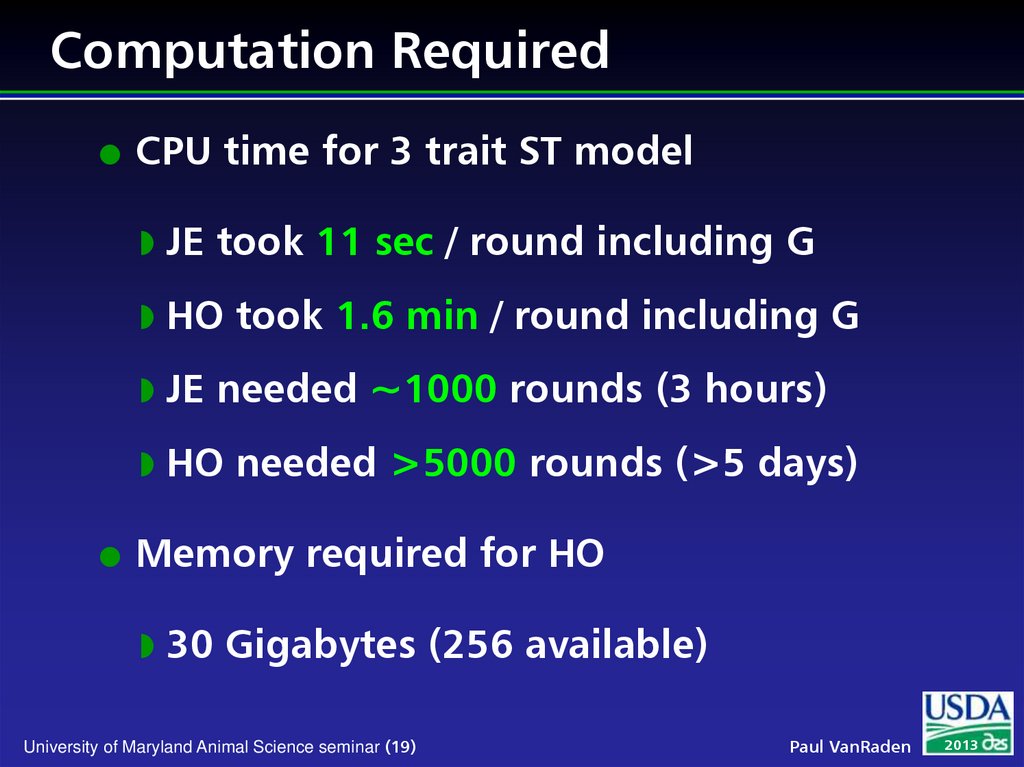

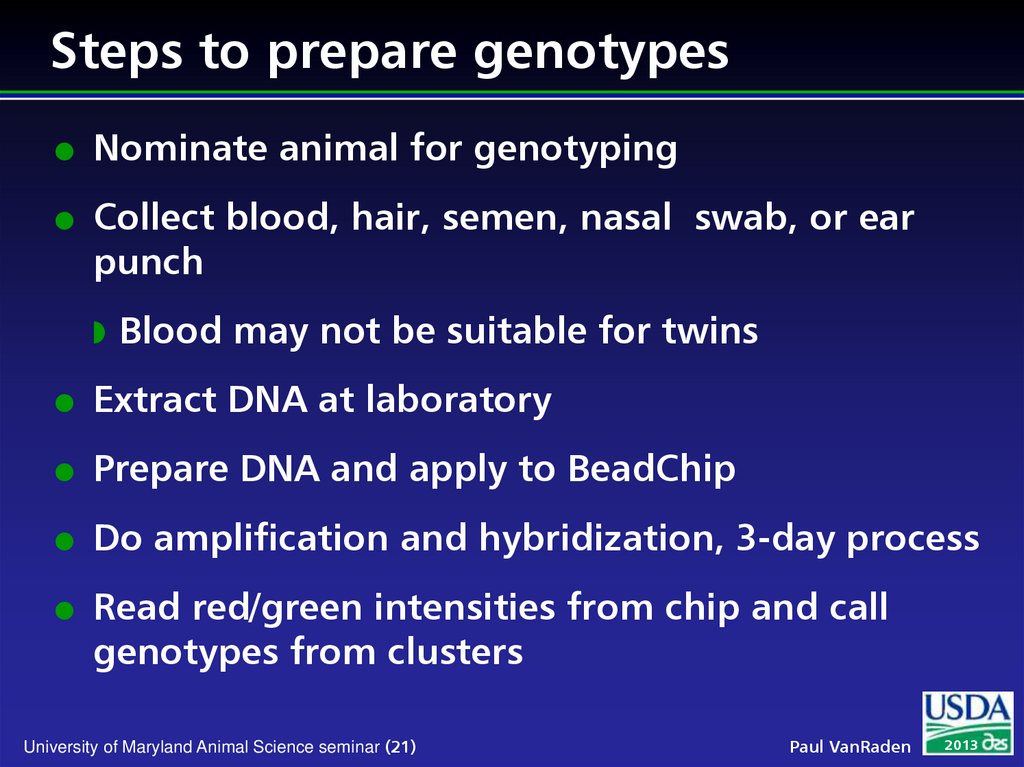
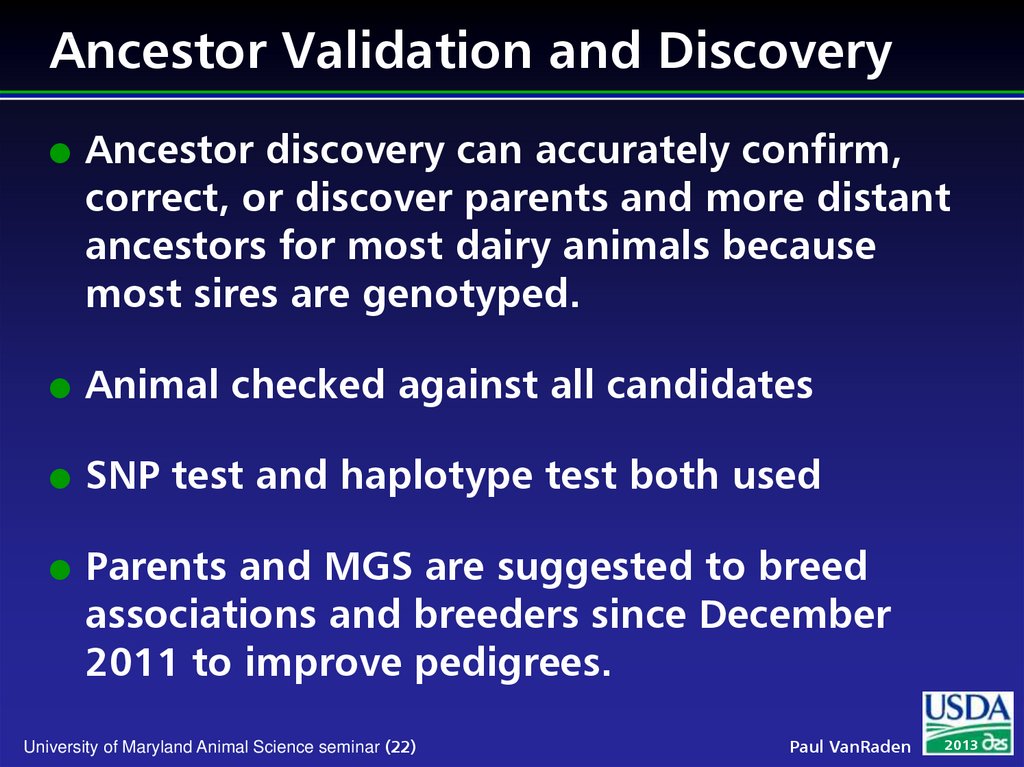

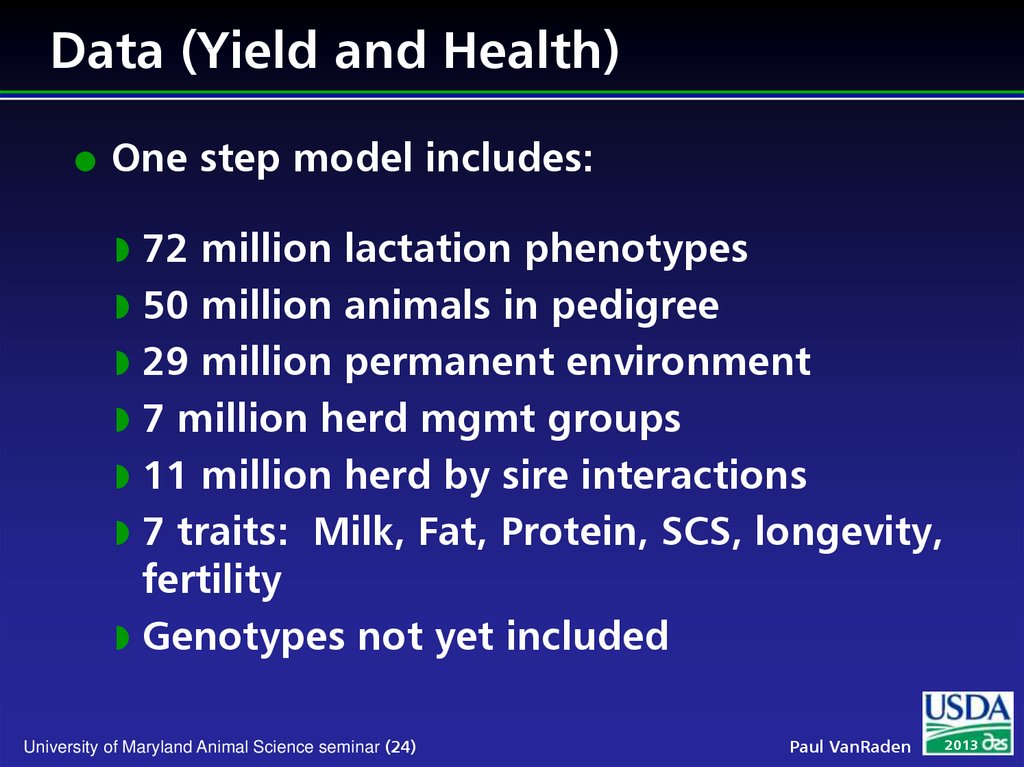
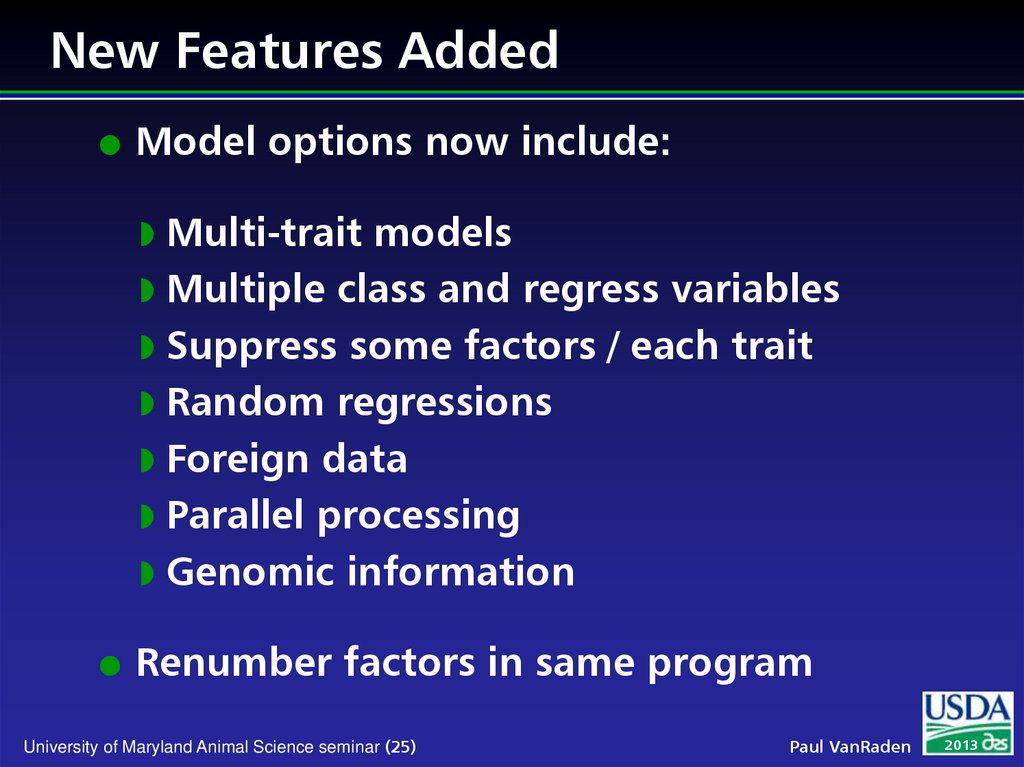

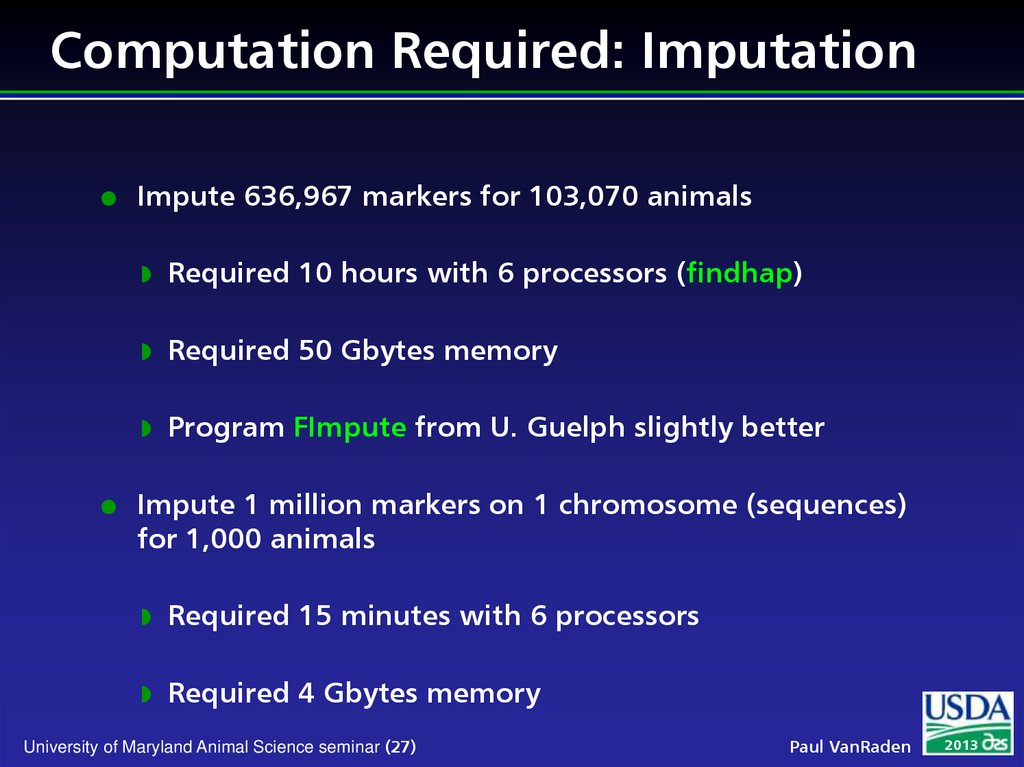
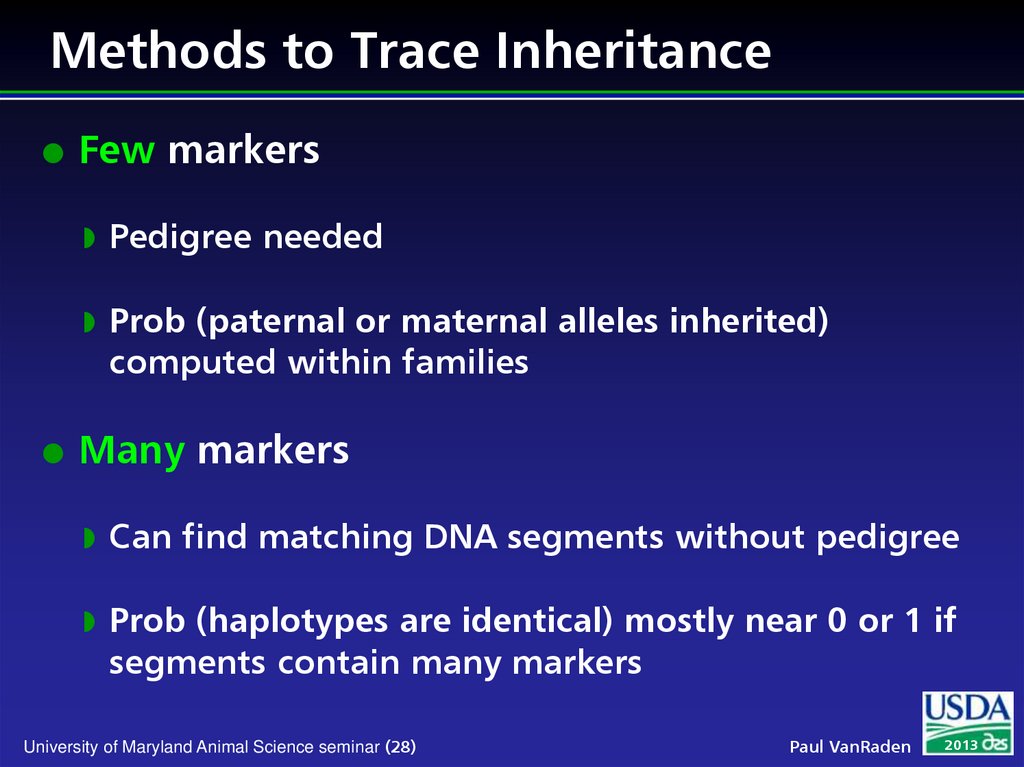
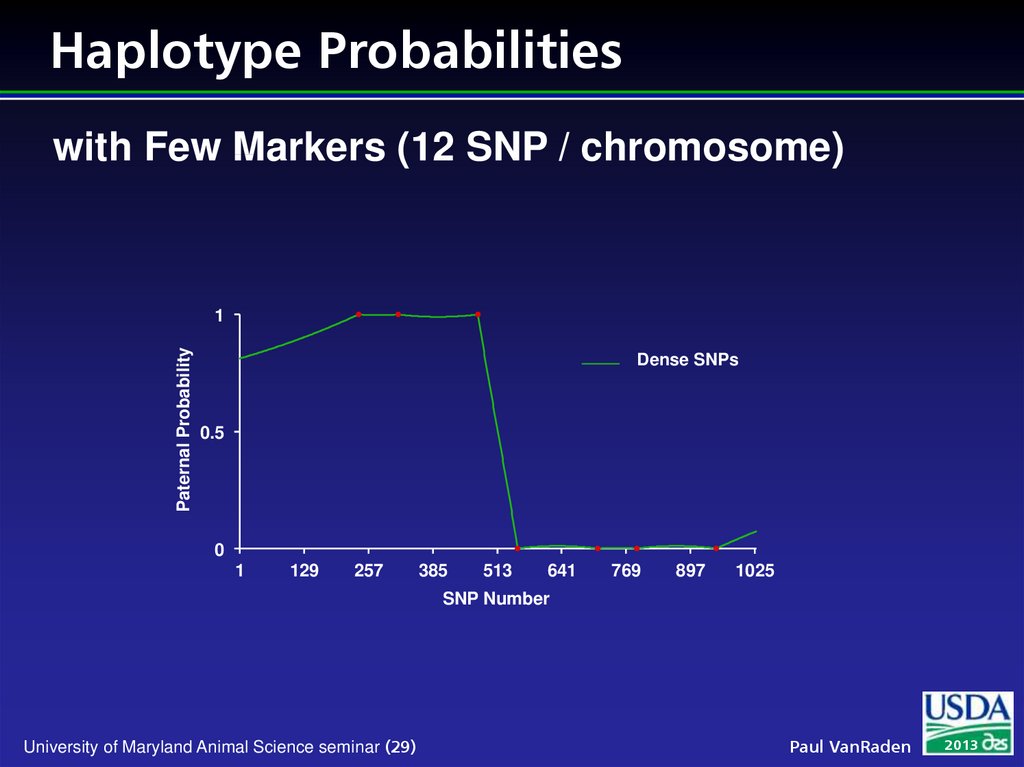
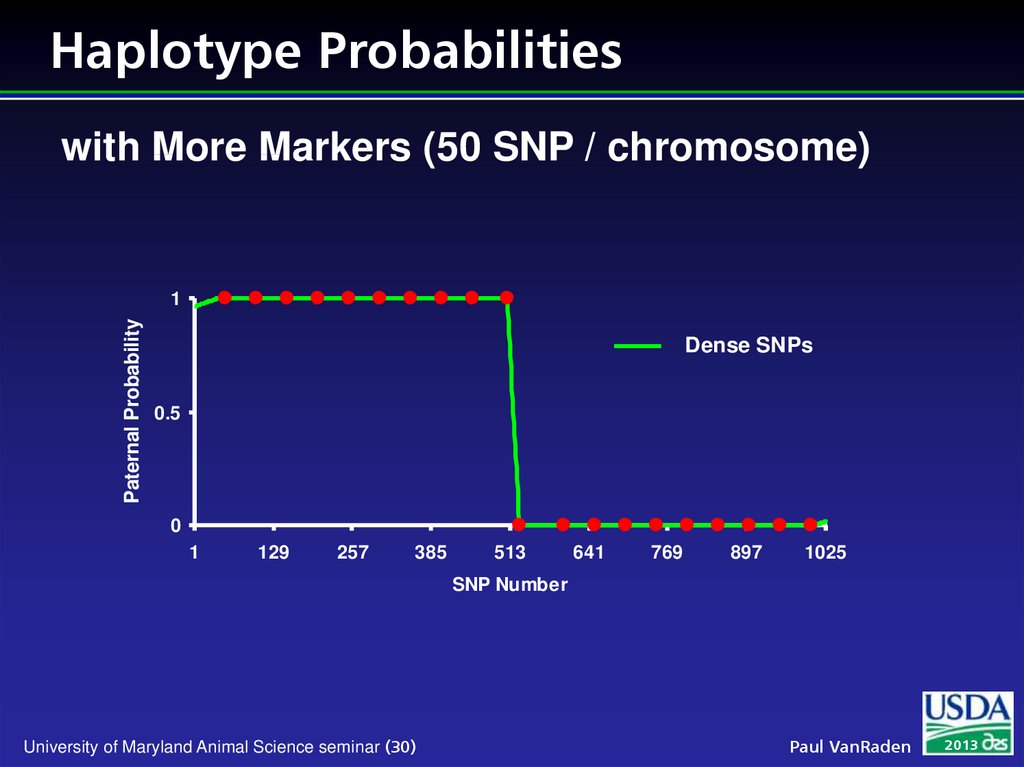
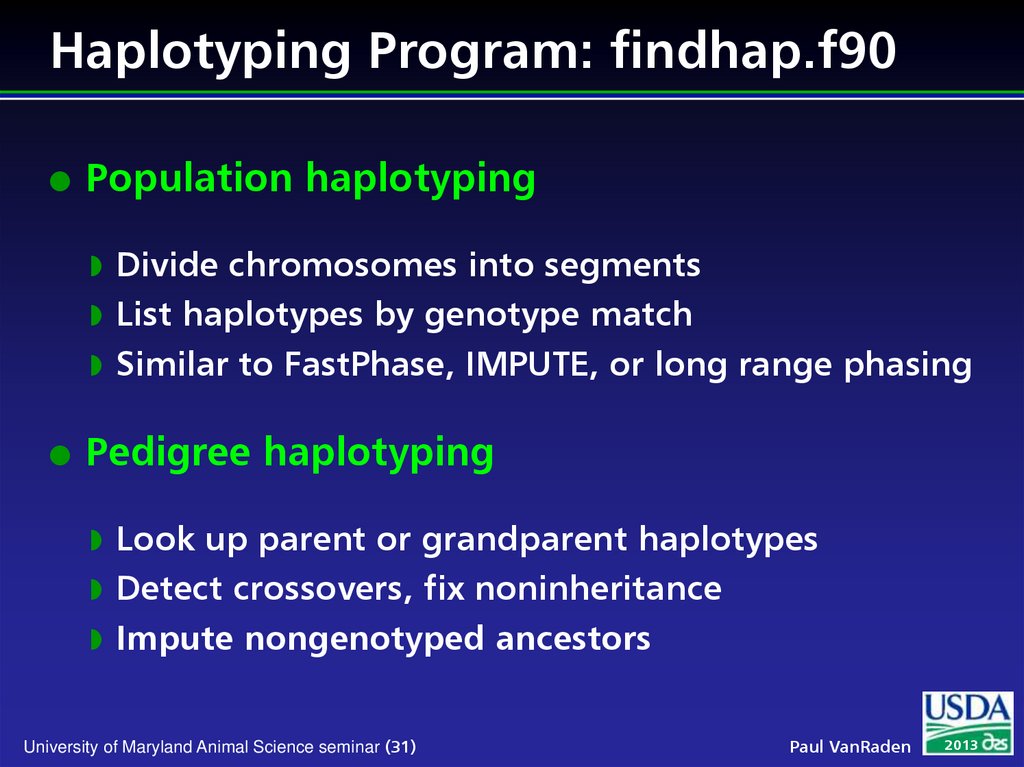
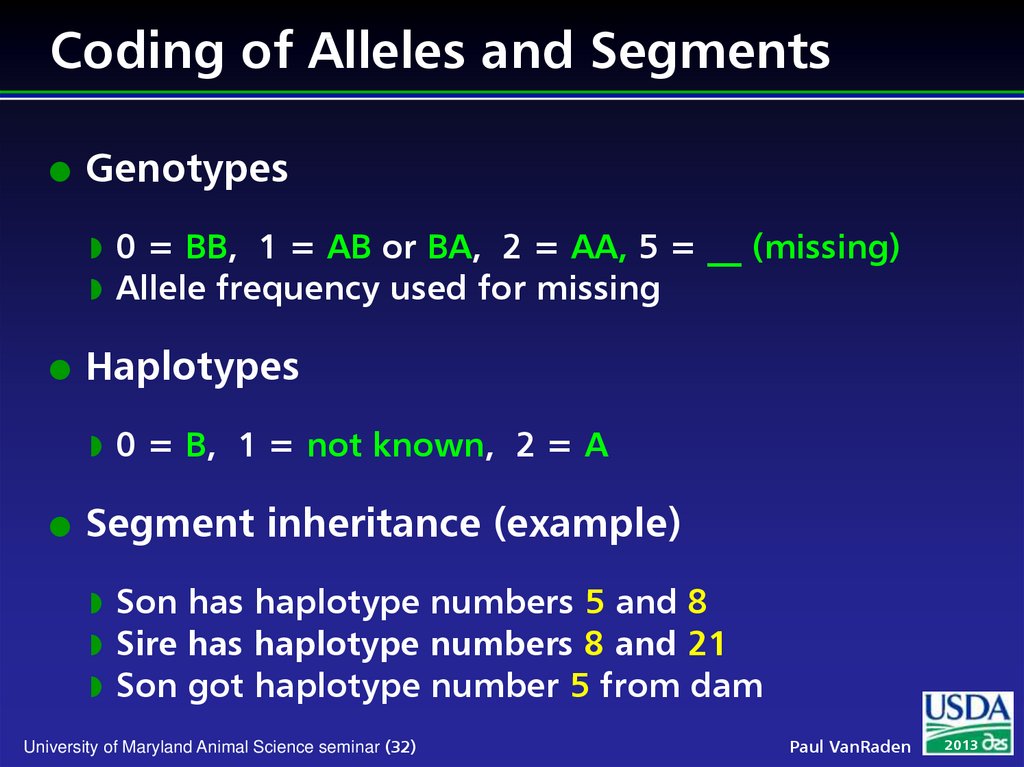
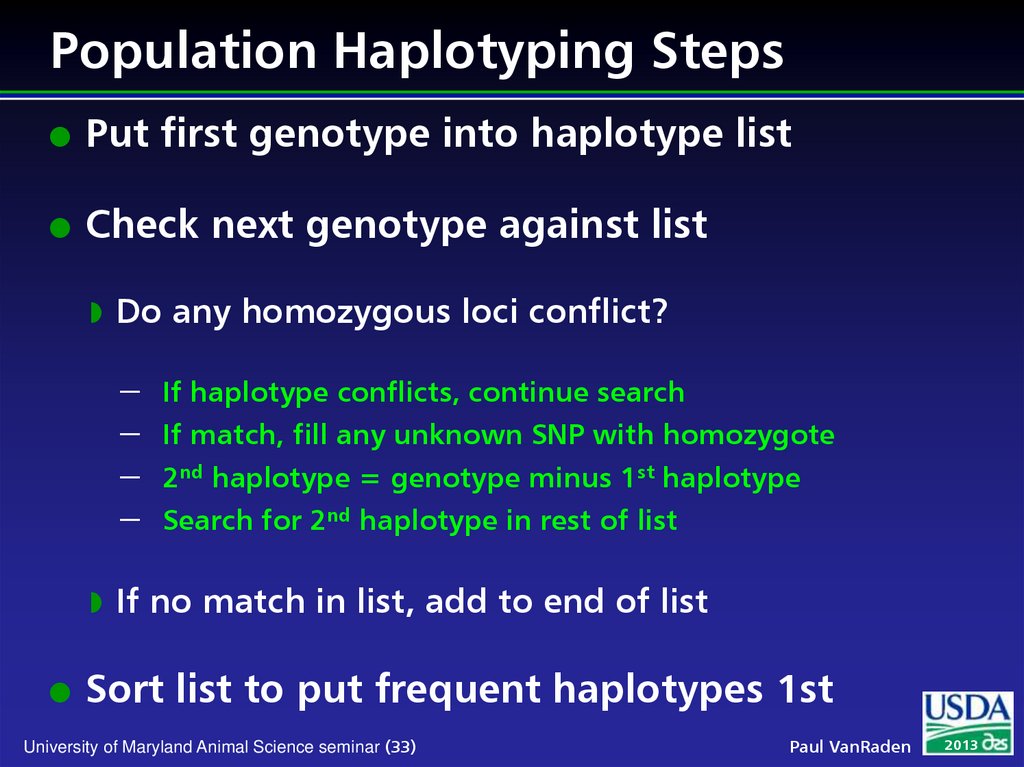
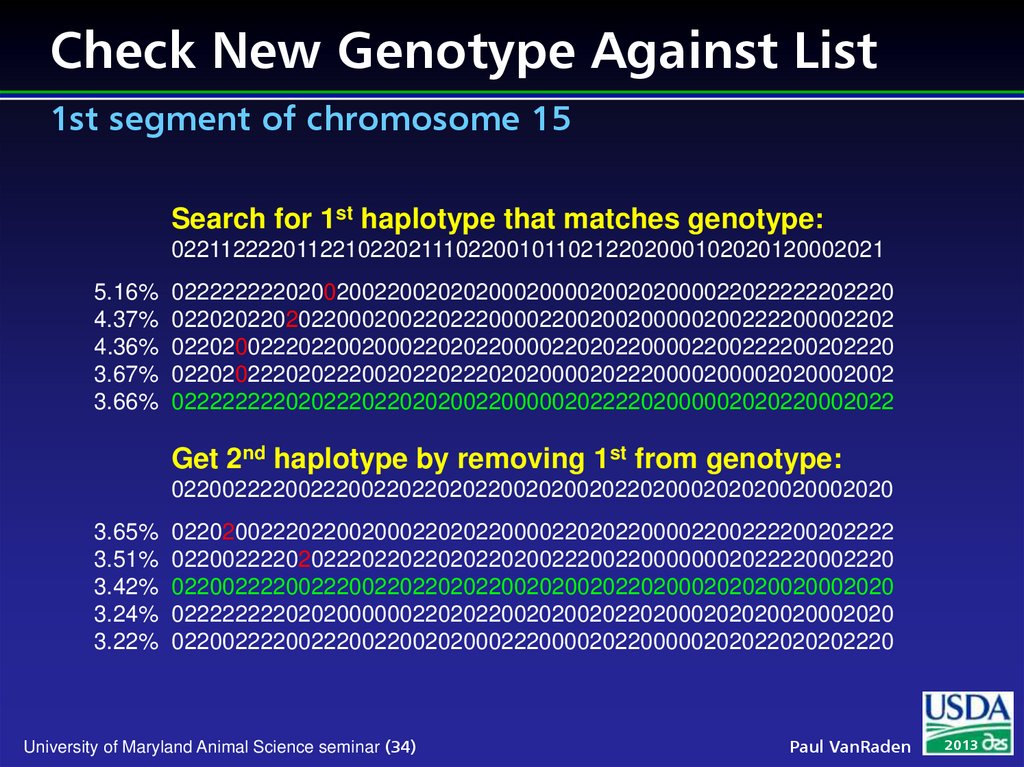
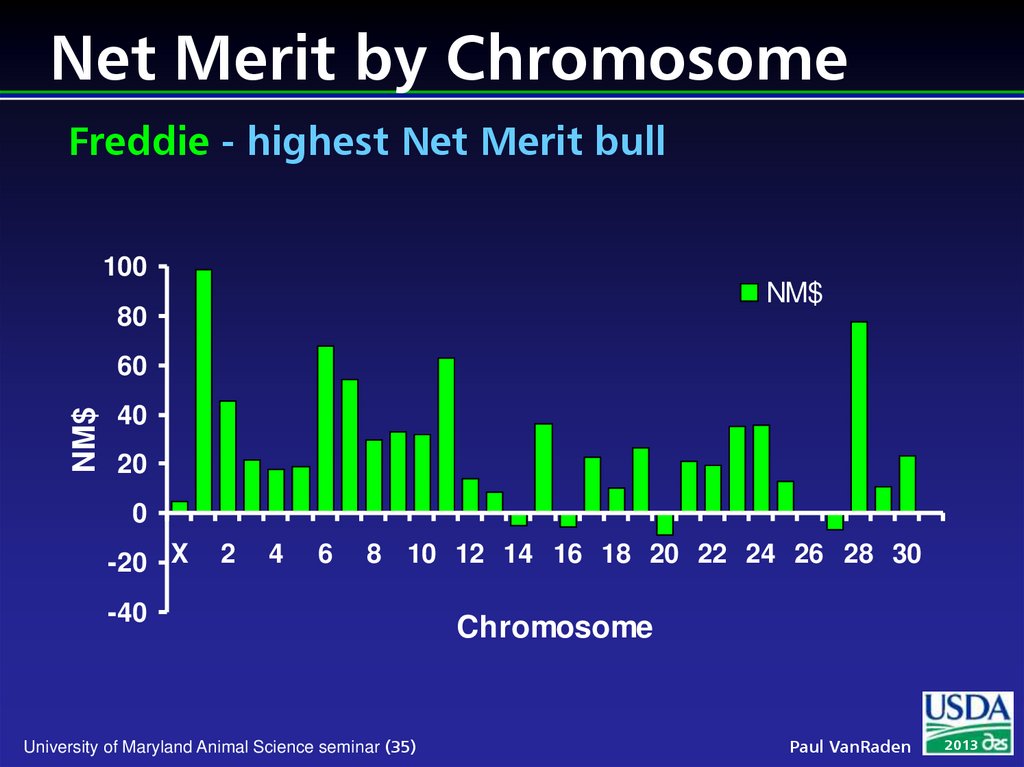
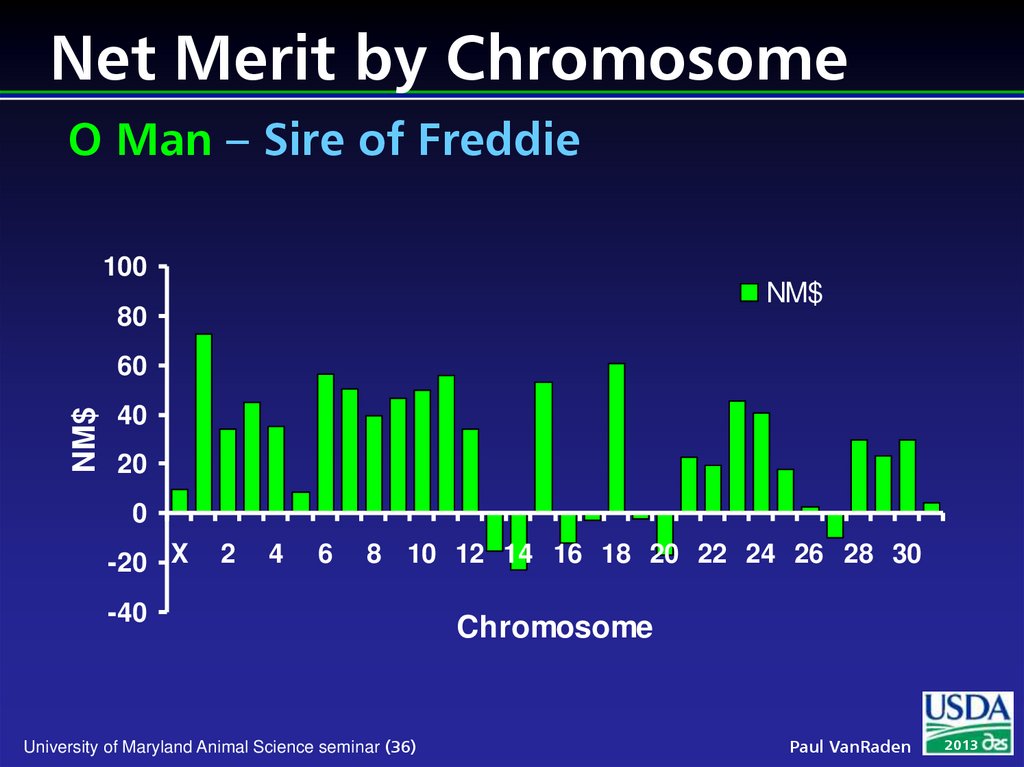
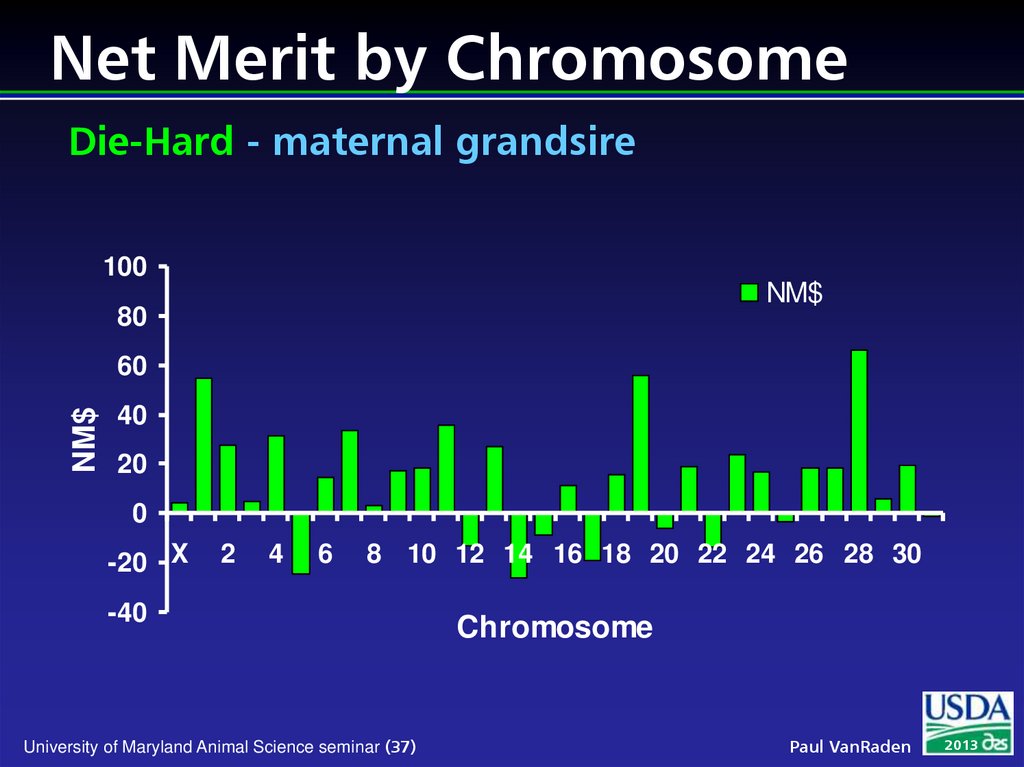
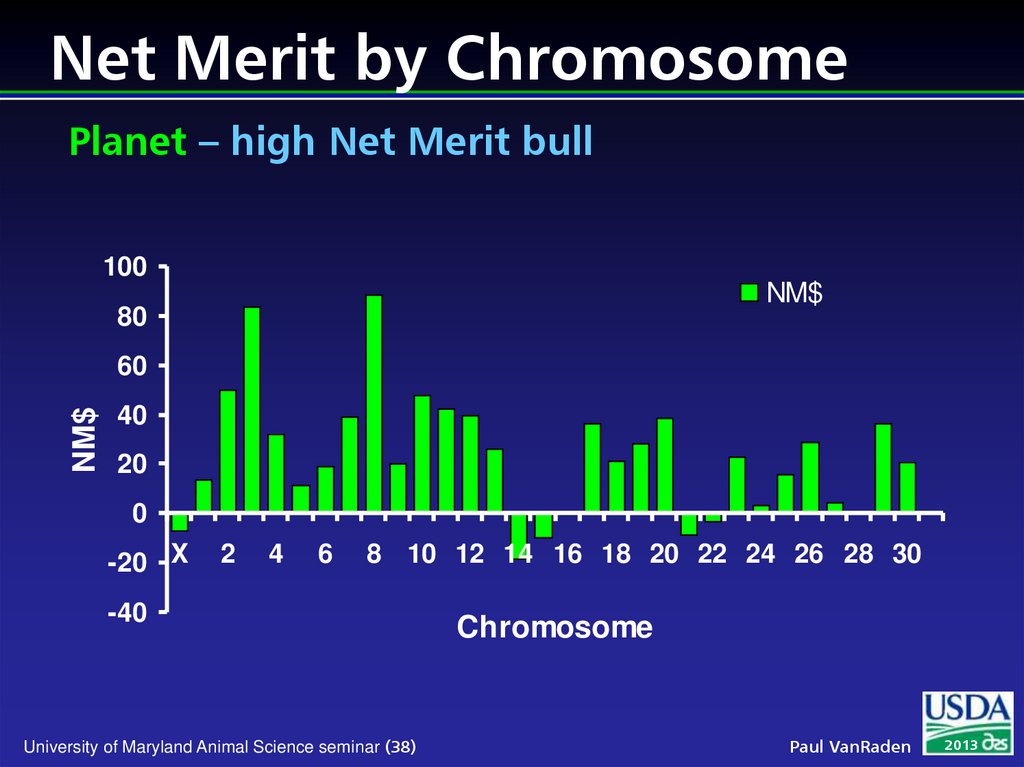
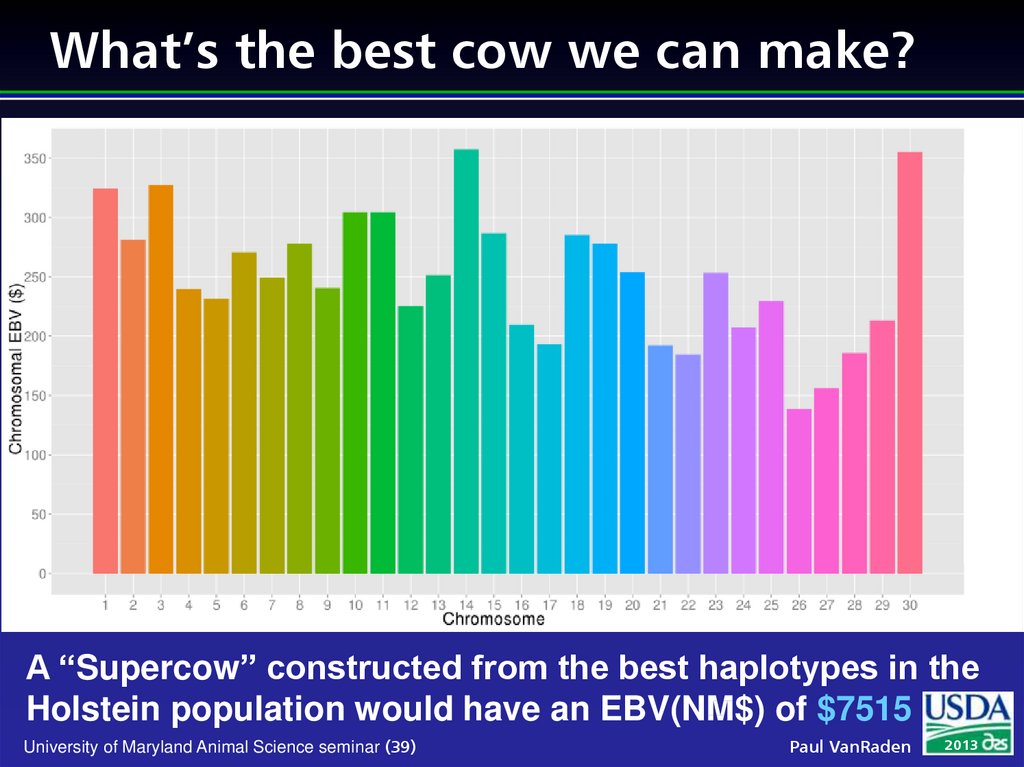
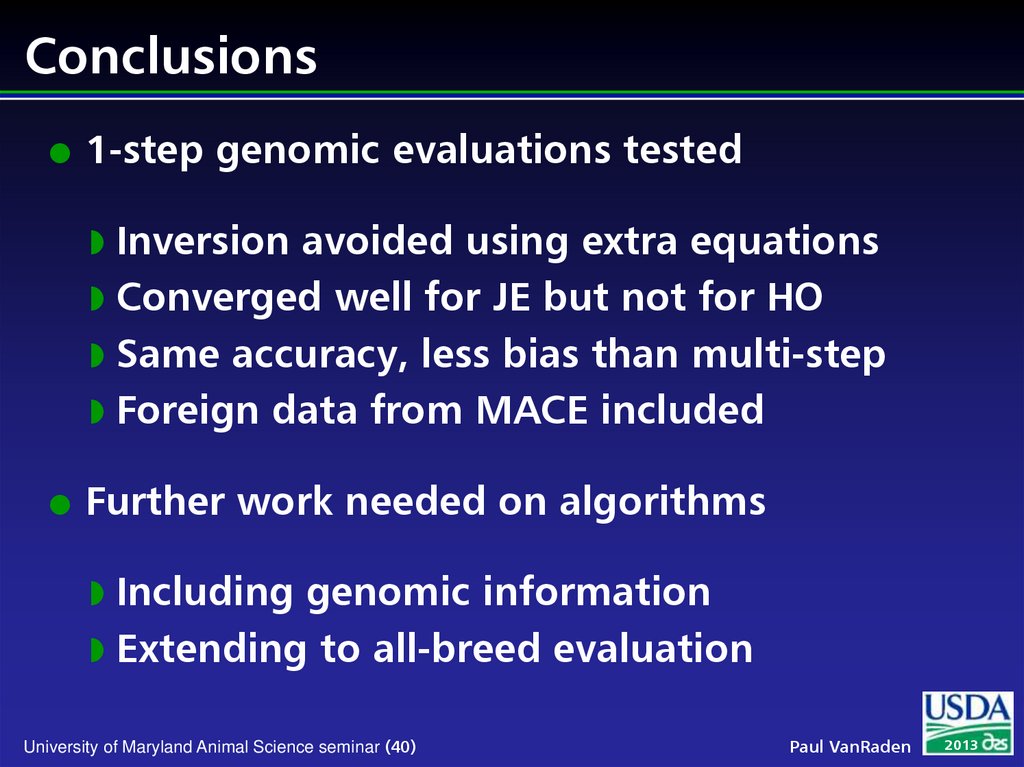
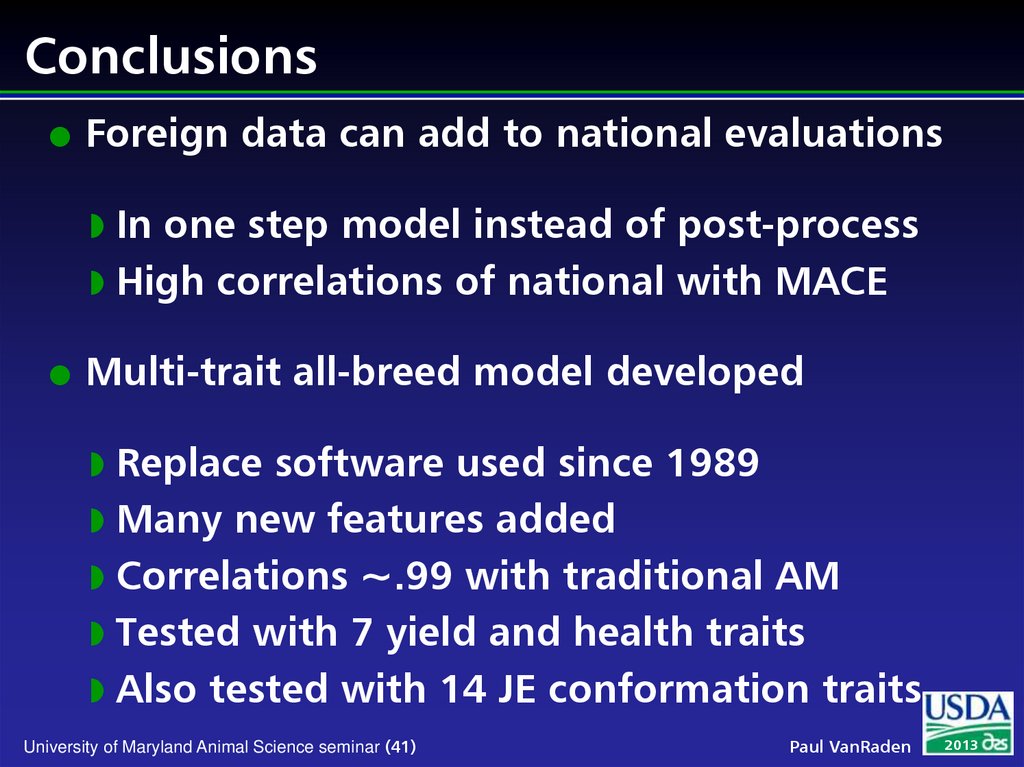
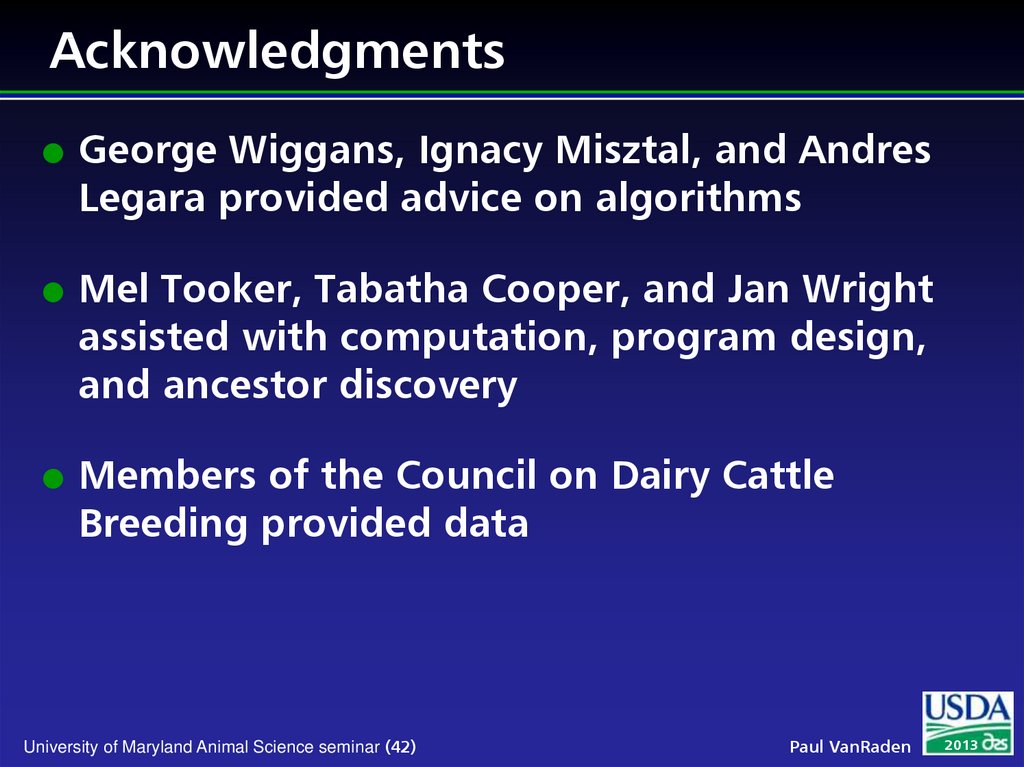
 biology
biology







